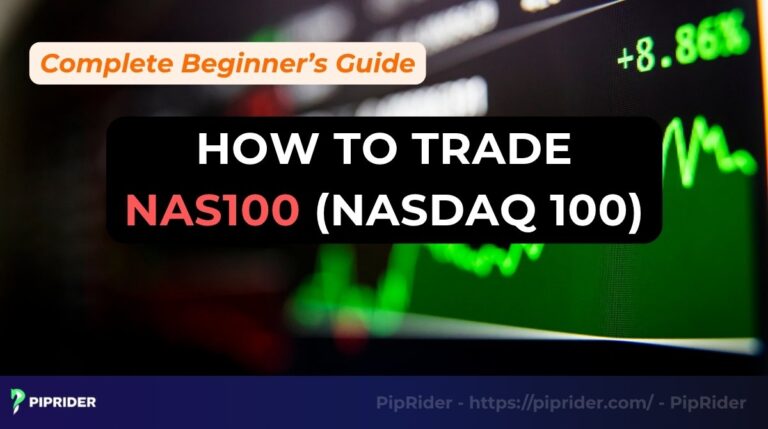Forex Order Blocks are a structural element of institutional trading activity identified through concentrated price action analysis. These zones mark where significant institutional orders were executed, establishing critical supply and demand imbalances.
Accurate utilization of order blocks enables traders to define high-probability entry points and refine risk parameters within a trade setup. This comprehensive guide provides the technical foundation, identification criteria, and practical strategies for trading with order blocks.
Key Takeaways
- Order blocks are specific price zones where institutional players (“smart money”) have accumulated significant orders.
- There are two main types: the bullish order block and the bearish order block.
- They are typically identified by a period of consolidation followed by a strong, decisive breakout.
- An order block often aligns with a key support or resistance level, increasing its significance.
- Traders use order blocks to define precise entry points, stop losses, and take profit targets.
1. What Are Order Blocks in Forex Trading?
An order block is a specific price zone on a chart that highlights a significant concentration of orders. These orders are often in the form of pending limit orders, placed by institutional traders (XS Markets, 2025; VPSForexTrader, 2025).
Think of it as the “footprint” of “smart money.” It represents the area where large players have accumulated their positions before initiating strong, decisive price movements, often after a period of price consolidation.
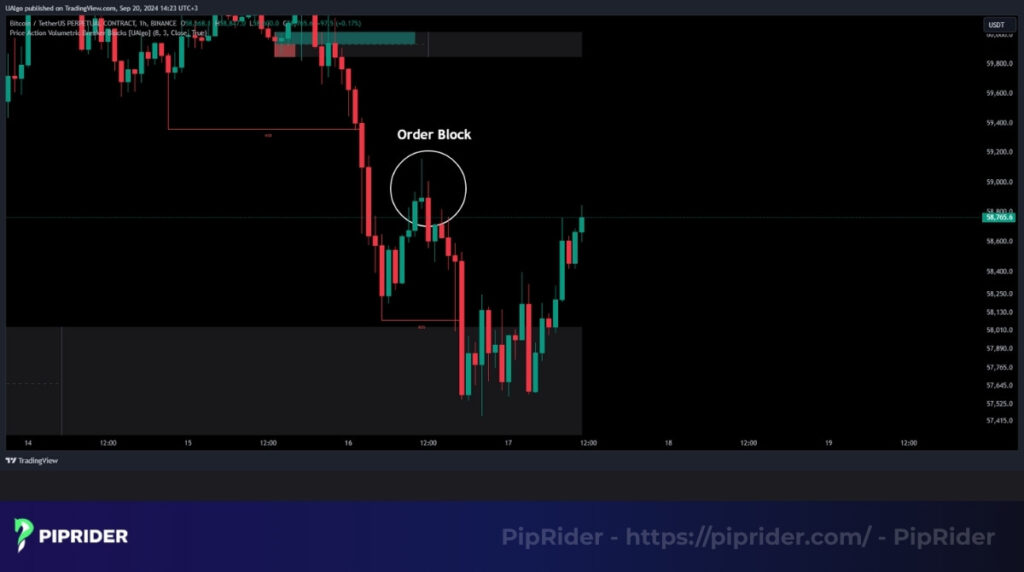
The idea originates from Smart Money Concepts (SMC), a theory suggesting that market trends are heavily influenced by these large players. An order block is critical because it marks a level where ‘smart money’ is likely to defend their positions. As a result, it becomes a high-probability area for a price reaction.
As a price action tool, order block analysis differs from traditional technical analysis and long-term investing. Instead of relying on lagging indicators, it focuses on reading the raw supply and demand story on the chart. In practice, order blocks act as powerful support and resistance zones, giving you a logical area to plan your trades.
2. Types of Order Blocks
In forex trading, order blocks are classified by the direction of the strong move they lead to. Differentiating between bullish and bearish order blocks is a foundational step for any analysis.
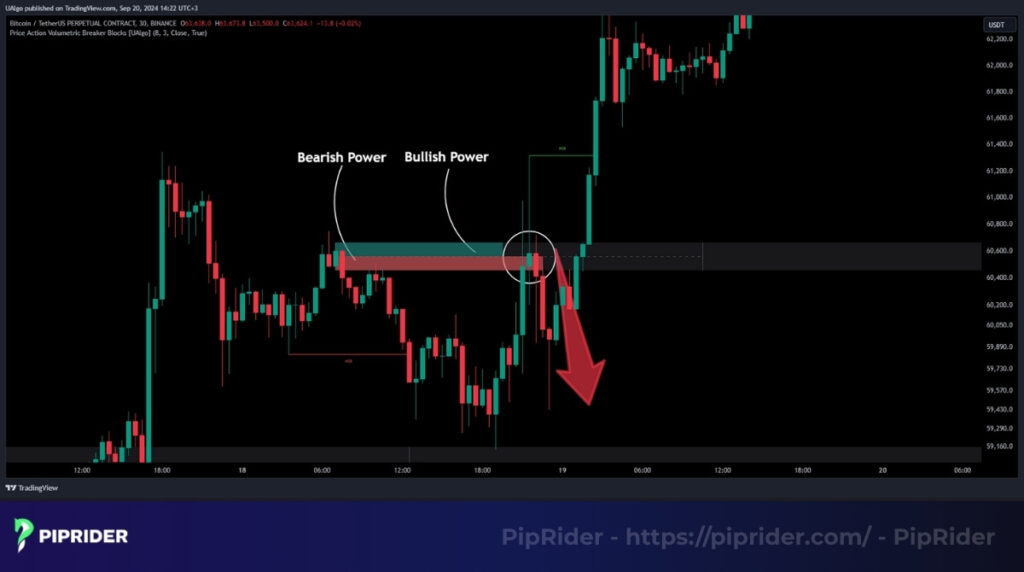
2.1. Bullish Order Block
A bullish order block is a price zone that forms immediately before a strong upward move. It represents a key area where institutional players have accumulated a high volume of buy orders, often after a period of price consolidation.
How to identify a bullish order block:
- The move: Look for a strong, impulsive move upwards that breaks a previous high (a break of market structure).
- The candle: The bullish order block is the last bearish (down) candle just before this powerful upward move begins.
- The function: When price returns to this zone, it is expected to act as a strong support level, providing a potential buying opportunity.
2.2. Bearish Order Block
A bearish order block is the mirror opposite of a bullish one. It is a price zone that forms immediately before a sharp downward move. This area represents a significant cluster of sell orders accumulated by institutional players.
How to identify a bearish order block:
- The move: Look for a strong, impulsive move downwards that breaks a previous low (a break of market structure).
- The candle: The bearish order block is the last bullish (up) candle just before this powerful downward move begins.
- The function: When price returns to this zone, it is expected to act as a strong resistance level, providing a potential selling opportunity.
3. How to Find an Order Block: A 3-Step Guide
Finding an order block is like being a detective looking for clues left behind by “smart money.” Here’s a simple 3-step process to identify these key zones on your chart.
3.1. Spot the Strong Move
First, scan the chart for a sharp, explosive price move that breaks out of a recent consolidation or familiar chart patterns. This powerful move is your first clue; it signals that large institutions have likely entered the market.
3.2. Find the “Opposite” Candle
Next, look at the candle immediately before this strong move starts. This is the key to finding the order block itself.
- For a Bullish (Buy) Setup: Find the last down-candle (bearish) right before the price shot up.
- For a Bearish (Sell) Setup: Find the last up-candle (bullish) right before the price dropped.
3.3. Look for Confirmation (Recommended)
Finally, a high-quality order block often has extra evidence supporting it. Before trading, check for these confirming signs:
- Imbalance (FVG): The strong move away from the block often leaves behind a large, inefficient candle (a Fair Value Gap), which is a strong sign of institutional activity.
- Candlestick patterns: The breakout move away from the order block is often a strong impulse candle or an engulfing candle, showing clear momentum.
- Volume: Look for a noticeable increase in trading volume accompanying the breakout move, as it confirms strong participation.
- Higher timeframe: The signal is generally more reliable if the zone is also visible on a higher timeframe.
4. How to Trade Using Order Blocks
Once you’ve identified a high-probability order block, the next step is to plan the entry, often taking advantage of the resulting volatility. The core strategy is to patiently wait for the price to return to the order block zone.
4.1. The Entry Strategy
The basic principle is to use the order block as a key support or resistance zone where institutions may have pending limit orders.
- For a Bullish Order Block (Buy Setup): After a strong upward move, we wait for the price to pull back down into the bullish OB zone. Don’t enter immediately. Instead, wait for one or more confirmation signals, such as a bullish engulfing candle before executing a buy order.
- For a Bearish Order Block (Sell Setup): Conversely, after a sharp downward move, wait for the price to rally back up into the bearish OB zone. Once the price retests this area, look for a bearish confirmation signal before executing a sell order.
The key is patience: let the price come to you and wait for confirmation before entering.
4.2. Stop Loss & Take Profit Placement
A good entry is only one part of a successful trade. Knowing where to place your stop loss and take profit is equally critical for managing risk when trading order blocks.
Stop-Loss (SL) Placement: The rule for placing your stoploss is logical and simple: it should go just outside the order block zone.
- For a bullish OB, place your stop-loss just a few pips below the low of the block.
- For a bearish OB, place it just a few pips above the high.
The reasoning is clear: if the price breaks completely through the institutional zone, the trade idea is invalidated.
Take Profit (TP) Placement: Take profit targets should be set at logical areas. Common targets include:
- Liquidity levels: The nearest significant high (for a long trade) or low (for a short trade), as these are areas where a price reversal might occur.
- Fair Value Gaps (FVG): Price is often drawn to “fill” any significant imbalances (FVG) that were created during the initial impulsive move.
4.3. Using Multiple Timeframe Analysis
Effective trade execution requires Multiple Timeframe Analysis (MTA) to confirm the higher timeframe trend before refining the entry on a lower timeframe. This method is adaptable for various styles, from scalping and day trading on lower timeframes to swing trading on the H4 and daily charts.
- The higher timeframe (e.g., H4, Daily): The “Direction” This is where you identify the main trend and the most significant order blocks. An order block on a daily chart carries much more weight.
- The lower timeframe (e.g., M15, M5): The “Entry Trigger” Once the price retests the major order block zone, you “zoom in” to a lower timeframe. Here, you wait for a smaller-scale confirmation signal to get a very precise entry with a tighter stop-loss.
4.4. Case Study Examples (EUR/USD & GBP/USD)
Theory is important, but seeing order blocks in action on a real chart is the best way to learn.
Case Study 1: Bullish Order Block on EUR/USD (H1 Chart)

On the 1-hour chart for EUR/USD, we observed a strong upward move that broke the previous market structure. We identified the last bearish candle before this move as our bullish order block. Price then pulled back and retested this zone. After seeing a bullish confirmation candle, we entered a long (buy) position. The trade played out perfectly, with the price bouncing strongly off the order block and rallying for over +50 pips.
Case Study 2: Bearish Order Block on GBP/USD (H4 Chart)
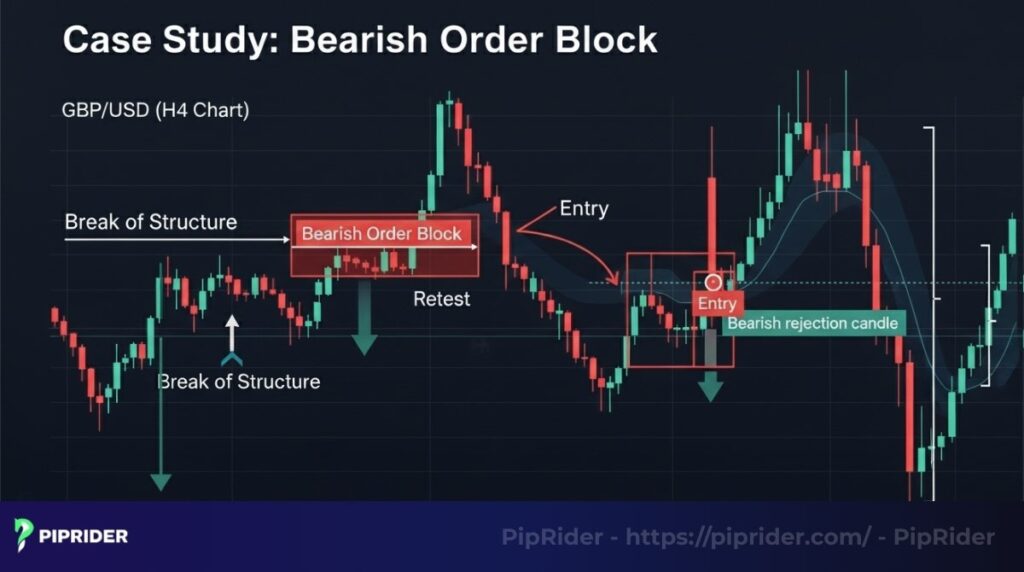
Looking at the 4-hour chart for GBP/USD, a sharp downward move broke a key low. We marked the last bullish candle before this drop as a high-probability bearish order block. Several hours later, the price rallied back up to retest this supply zone. Upon seeing a bearish rejection candle, we entered a short (sell) position. The order block acted as powerful resistance, and the price was rejected strongly, leading to a significant downward move.
5. Common Mistakes When Using Order Blocks
While order blocks are a powerful tool, misuse can lead to unnecessary losses. Being aware of these common pitfalls is crucial for consistent trading.
Here are the most frequent mistakes:
- Over-marking order blocks: The error of identifying too many potential order blocks on the chart. This leads to analysis paralysis and chart clutter.
- Isolated order block trading: Relying solely on an order block without considering broader market context like a break of market structure or volume.
- Absence of clear risk management: Entering trades without a pre-defined stop-loss or proper position sizing. This exposes capital to excessive risk.
6. Order Blocks vs. Supply & Demand Zones: What’s the Difference?
Traders familiar with price movements often ask: “Aren’t order blocks just a fancy name for supply and demand zones?” While similar, they have key distinctions. This is also true for related concepts like breaker blocks.
Understanding these differences can significantly refine your analysis.
| Feature | Order Blocks | Supply & Demand Zones |
| Definition | A specific price zone defined by institutional order accumulation. | A broader area where price showed a strong imbalance between buyers and sellers. |
| Origin | Smart Money Concepts (SMC) | Traditional price action theory. |
| Identification | The last opposing candle before a strong breakout. | Identified at significant swing highs and lows. |
| Signal | A specific Bullish or Bearish OB candle. | Price returning to a general zone of supply or demand. |
| Application | Used for precise entries with a tight stop-loss. | Identifies a general area for a potential reversal. |
| Precision | Often considered higher probability as it reflects institutional behavior. | Can be less precise without extra confirmation. |
7. Combining Order Blocks with Other Tools for Higher Probability
While a high-quality order block is powerful, its probability increases significantly when it aligns with other tools. This alignment is what traders call “confluence.”
Here are a few powerful combinations:
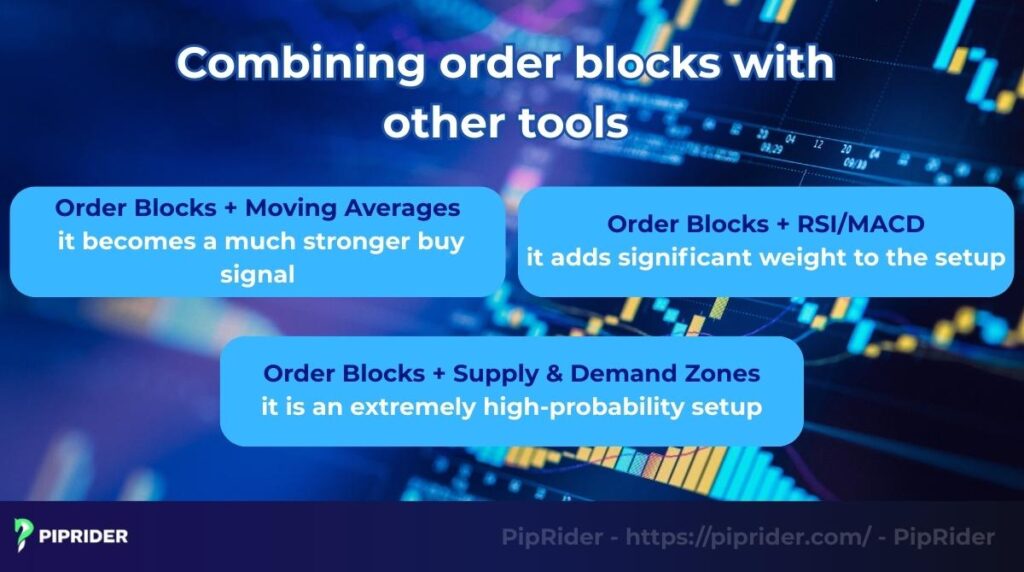
- Order Blocks + Moving Averages: If a bullish order block forms at a key moving average (like the 50 EMA) acting as support, it becomes a much stronger buy signal.
- Order Blocks + RSI/MACD: When price retests an order block, check your RSI or MACD. If the RSI is showing divergence during a period of low volatility, it adds significant weight to the setup.
- Order Blocks + Supply & Demand Zones: An order block that forms within a larger supply and demand zone from a higher timeframe is an extremely high-probability setup, as the market order flow is aligned.
8. FAQs on Forex Order Blocks
9. Summary
Forex order blocks are a powerful tool that allows traders to read the behavior of large institutions and find precise trade opportunities. When you combine order block analysis with disciplined risk management, multiple timeframe analysis, and other confirming tools, you can significantly increase the reliability of your trading signals and improve your long-term performance.
To continue building on these advanced price action techniques, we encourage you to explore more guides in our Learn Forex category on Piprider.








